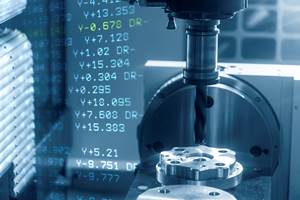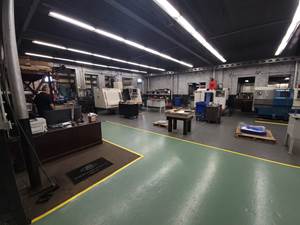Need For Change Brings Unexpected Benefits
This manufacturing company was faced with a dilemma common to many companies in today's manufacturing environment. Change their process to include CNC or lose valuable customers.
Share





Eaton Corporation in Arab, Alabama, was faced with a dilemma common to many companies in today's manufacturing environment: change their process or lose valuable customers. Eaton manufactures motor controls with unique triggerhead geometry for various industries including those for power tools. One of their main customers made a decision to require all suppliers to accept only CAD data, exchange data via magnetic media, and to cut all parts using CNC.
This posed an immediate problem for the model shop because they had no CNC machines, and all of their parts were either created by hand or machined using manual machines. Adhering to this new directive would also involve a major process change. Eaton's current process involved using a model maker or die maker to generate the part, then completing it with some hand finishing.
Any jobs that could not be accomplished using this process had to be outsourced. Also, in addition to finished parts, their customers were starting to require Eaton to produce prototype parts quickly and accurately.
When they started looking for solutions, they had some major concerns because their product line contains some very detailed, small, tight tolerance parts. Some of these include trigger heads that measure 1 inch by 1 inch and are barely 1 inch in height. These also have many intricate nooks and cranies that require tolerances to 0.0005.
Eaton selected Acu.Carv (Olmsted Engineering Co., Traverse City, Michigan) for their CAM system. According to Jim Kemp of Eaton, they made this decision based on two main premises. One, the software was very intuitive, thus making it very easy to use, and two, the EDM module is designed for EDM and not a modified mill package. This means that a knowledge of how controllers function and their capabilities is built into the software, thus certain programming options are easily available and there is no editing of the G-code file required.
One of the options that Eaton liked was that, given a part file, they could quickly generate G-code for the true part geometry (without any offsets, wire diameters, and so on) without having to go through icons or parameter data changes. Also, once they became more comfortable with the control it was just as easy to generate a complete G-code file on the computer, including taper, gluestops, and automatic skim cuts. The software also provided an easy way of creating four-axis code without having to draw or receive the part data in 3D.
The learning curve was also very important to Eaton since they had very little CNC or computer experience. They first went to GFAGIECHilles for EDM training to learn the machine's functions and the capabilities of the controller. They also learned how to program parts manually on the controller. According to Mr. Kemp they were told by other area shops producing similar parts not to expect to be producing their complex four-axis products efficiently for three to four months or so. After contacting some existing Acu.Carv users, Eaton decided to start programming the wire EDM using Acu.Carv without attending training. Mr. Kemp stated that "After going through the tutorials and a couple of calls to Olmsted Engineering for support, we were producing production quality intricate parts within three days after returning from EDM training."
In addition to the dies, they produce many small molds that have deep straight wall cavities with many intricate shapes.
Prior to their purchase of the wire EDM and the software, they would produce these molds using a machine. Due to the small deep cavities there would be problems with arcing and inevitably they would lose two or three pieces before getting a good part.
Eaton now uses their wire machine to cut these parts. First they cut the cavity shape straight through the part. Next, they cut a plug out of another piece of metal the same shape as the cavity. The plug is then placed in the cavity to make the cavity the proper depth. Jim Kemp says that they can accomplish this because with the Acu.Carv/GFAGIECHilles combination they can hold the plug and cavity tolerances within a tenth thus creating screwless molds that provide many advantages over the old method. One is the time savings, up to 75 percent on these types of molds. Another major advantage is that this method creates a natural vent between the plug and cavity which allows gases to escape. This has added a crucial element to their manufacturing process and has led to more consistent parts.
Mr. Kemp stated that "Eaton has found that what at first looked like an uncomfortable situation has turned into a fortunate one in a very reasonable amount of time. We have been able to make full use of our controllers capability and reduce the amount of hand work and out-sourcing that we do. All this has resulted in better production and faster turnaround times. We would encourage anyone considering the same moves we made to give it a go." MMS
Related Content
Tips for Designing CNC Programs That Help Operators
The way a G-code program is formatted directly affects the productivity of the CNC people who use them. Design CNC programs that make CNC setup people and operators’ jobs easier.
Read More6 Machine Shop Essentials to Stay Competitive
If you want to streamline production and be competitive in the industry, you will need far more than a standard three-axis CNC mill or two-axis CNC lathe and a few measuring tools.
Read MoreCan AI Replace Programmers? Writers Face a Similar Question
The answer is the same in both cases. Artificial intelligence performs sophisticated tasks, but falls short of delivering on the fullness of what the work entails.
Read MoreFrom Tradition to Transformation: Century-Old Manual Machine Shop Adds CNCs
After 122 years of working with manual mills and lathes, this fifth-generation shop acquired assets of a local CNC machining business and hired the owner. Here’s how it’s going a year later.
Read MoreRead Next
Machine Shop MBA
Making Chips and 91ÊÓƵÍøÕ¾ÎÛ are teaming up for a new podcast series called Machine Shop MBA—designed to help manufacturers measure their success against the industry’s best. Through the lens of the Top Shops benchmarking program, the series explores the KPIs that set high-performing shops apart, from machine utilization and first-pass yield to employee engagement and revenue per employee.
Read MoreAMRs Are Moving Into Manufacturing: 4 Considerations for Implementation
AMRs can provide a flexible, easy-to-use automation platform so long as manufacturers choose a suitable task and prepare their facilities.
Read More





















